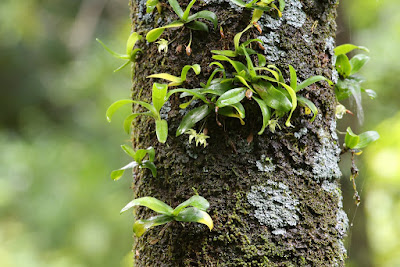Aeranthes orchid is found mostly on the islands of Madagascar, Comoros, and the Mascarenes and two species comes from the mainland of Africa. Its grows from shady, tropical humid forests, often on rocks at elevation of 1000-1500 meters above sea level.
Aeranthes orchid also called as Aeranthus, is a genus of the Orchidaceae family. This genus was described by John Lindley in 1824. The name "aeranthes" means "aerial flower", refers to their epiphytic growth habit.
IDENTIFY AERANTHES ORCHID PLANT
Aeranthes orchid is found mostly on the islands of Madagascar, Comoros, and the Mascarenes and two species comes from the mainland of Africa. Its grows from shady, tropical humid forests, often on rocks at elevation of 1000-1500 meters above sea level.
It is a monopodial epiphytes with short stems. Their roots are usually fine. The inflorescences are axillary, one- to several-flowered, usually unbranched, often pendent, with very slender stalks.
The plants from this genus bloom in summer or in autumn and the duration of flowering is 2-3 months. The flowers are characterized by an insect or spiderlike appearance. They are translucent, green or yellowish, rarely white, with the lateral sepals joined to the column foot. Some give an agreeable, sweet scent in the evening or early morning. The sepals and petals are similar, usually acuminate. The lip is unlobed, the spur arising from the column foot. Column long or short; pollinia two, stipites two, viscidia two; rostellum side lobes longer than the midlobe.
AERANTHES ORCHID PLANT CARE AND CULTURE
Cultural information should only be used as a guide, and should be to be adapted to suit you. Your physical location; where you grow your plants, how much time you have to devote to their care, and many other factors, will need to be taken into account. Only then can you decide on the cultural methods that best suit you and your plants.
Light:
Aeranthes orchid like a lot of light, about 24000-36000 lux. But the direct sun must be avoid. The light should be filtered or dispersed, about 70% shade is recommended.
Temperature:
The plants from this genus belongs to the warm temperate. Day temperature at 15 to 25 ° C and 14 to 18 ° C in the night with a diurnal range from 3 to 5 ° C.
Humidity:
These plants need the humidity of 60 to 80%. Easy dehydration if the atmosphere is dry. Vaporization daily by ensuring that water does not stagnate at the point of attachment of leaves. Essential ventilation if the atmosphere is very humid.
Substrate, growing media and repotting:
Aeranthes orchid can be grown in pots or in hanging baskets with an open mix to allow good drainage( tree fern, bark or osmunda). Repotting is done every 2 years to ensure a good balance of the plant with hanging inflorescences. The best time for transplanting is the period immediately after flowering and until the moment when new young shoots begin to grow their own roots.
Watering:
The plants from this genus need regulars water all year round, never allow plants to dry out. As long as medium is fresh and does not remain soggy, apply water liberally, especially when the plant is in active growth.
Fertilizer:
Use balanced fertilizer throughout the year once a month. Do not allow fertilizer salts to build up. Flush with clear water every month to avoid this.
Rest period:
Aeranthes orchid needs a well-defined dormant period. It begins, as a rule, in the middle of November, and consists in the fact that orchids are much drier and colder than usual and not fertilized. Watering should be replaced with a light, clear spraying of the substrate. After the appearance of peduncles, the dormant period ends: watering is resumed in the usual volume, and the total temperature of the content rises.
BUY AERANTHES ORCHID PLANT AND RELATED PRODUCTS
SOME SPECIES AND HYBRIDS OF AERANTHES WITH CULTURE SHEET AND CARE TIPS:
- Aeranthes arachnites - The Spider Aeranthes
- Aeranthes caudata - The Tailed Aeranthes
- Aeranthes grandiflora - The Giant-Flowered Aeranthes
- Aeranthes neoperrieri - Perrier's New Aeranthes
- Aeranthes orthopoda - The Straight-Footed Aeranthes
- Aeranthes ramosa - The Branched Aeranthes
- Aeranthes strangulata















COMMENTS